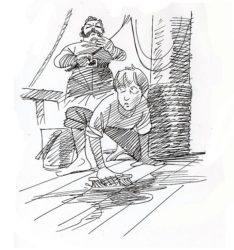Date/Time
Date(s) - Monday 11 November 2019
8:00 pm - 9:00 pm
Location
Duke Street Church
Categories No Categories
Scroll down for a report by Christopher Lynch on this talk
The Marine Society is perhaps best known for its pivotal role in supplying the Navy during manpower crises in the 18th century. Dr Caroline Withall‘s research highlights a lesser known aspect of the Society’s work, the recruitment of boys as apprentices to merchant ships, drawing attention to these forgotten boys.
Using the Society’s apprenticeship registers and correspondence books, data has been gathered on approximately 25,000 boys and analysed not only to to develop a missing piece of maritime history, but also to consider a number of important themes with wider significance to social and economic history. For example, the patronage of the East India Company; popular trade routes; the supply and demand of the sector; and ports the boys were sent to, both home and abroad. The registers are comprehensive in recording the boys’ background details, such as parental occupations; ages boys were sent to sea; previous occupations and age starting work; and the locations boys were recruited from, which provide a lens into the child and young adult labour market of the time.
The register data is brought to life by the Society’s treasure trove of correspondence, and together with contemporary newspaper reports, enables reflection on recent themes in social history. For example, the boys’ own agency in their placement; skills they learned both in training and once at sea; and their care and monitoring post placement.
It is also a fantastic source to track social mobility and apprenticeship outcomes, as there are details of further employment at sea, shipwreck, absconsion, discharge, illness, injuries, and in some instances, a grisly end. Individual tales of tragedy and triumph reveal what life was truly like for the boys who rode the crest of the wave; from harrowing accounts, such as that of Edward Kelly, who was so badly beaten he almost lost the use of his arm, to success stories like George Byworth, who enjoyed a long career at sea with the East India Company after first being placed with them by the Society.
Caroline’s talk will be of particular interest to us, as over 50 boys from this area, including Richmond, Kew, Mortlake and Ham, were placed out to sea, and she will be including some of their stories.
Dr Caroline Withall is a social and economic historian, primarily interested in 18th and 19th century child labour. Originally from Liverpool, she has also always had a strong interest in maritime history.
She is a British Library Research Affiliate and a former Caird Research Fellow at the National Maritime Museum in Greenwich.
Christopher Lynch reports on Dr Caroline Withall’s talk
The century-long archives of the Marine Society (1772–1873) list the names of some 25,000 boys apprenticed in a variety of jobs in commercial shipping. Some were as young as 10 and some as old as 21 but most were in the 14–16 age range.
This engaging talk featured tales of boys from Richmond, Kew, Ham and Petersham seeking apprenticeships or finding themselves placed in apprenticeships. Using the evidence of indentures, Society reports, newspaper accounts and one remarkable letter from a boy to his mother, Dr Caroline Withall revealed telling glimpses of the boys’ experiences.
Some of the boys had actually been working on ships before they were apprenticed. One such was an 11-year-old Richmond boy Robert Freeman who found himself working in the brutal conditions of a convict ship to Australia in the 1830s. Another local boy was Henry Hollins whose apprenticeship entailed travelling to the West Indies.
Apprenticeships ran for about five years and upon a successful completion the boys would be paid £30–35 for the total time. Some delinquent boys were pressured into apprenticeships in the 18th century, but the Marine Society became more selective from the 1820s onwards. It is clear from the records of the boys’ fathers’ occupations that a position as an apprentice in commercial shipping could be desirable, particularly if, for instance, the 13-year-old was the eldest of ten children. It would mean one fewer mouth to feed in a hard-pressed family.
If the Society recruited a boy from the workhouse then a fee of three shillings was payable. This happened less frequently as the position of apprentice became more attractive, either to the boys themselves or to their parents. Fifty-five per cent of the boys were brought to the Society by their fathers. Most of these fathers were labourers, shoemakers, coachmen, porters or weavers and no doubt were motivated by wanting their sons to be gainfully employed as well as becomingless of a burden.
The profile of the boys’ mothers’ occupations included washerwomen (most numerously) charwomen, servants and nurses. Intriguingly one mother identified her specialist occupation as a ‘sheep trotter scrapper’.
The boys were inducted into their apprenticeships through a three-month training period. For many this took place aboard the training ship Warspite, moored in Deptford. While it is recorded that they were to learn the laws of navigation, in practice this would have meant little more than noting wind direction and keeping an eye of the relative positions of boat and shore.
Apprenticeships with the East India Company entailed more formal training, with its boys learning compass skills and working with the complicated mechanisms of great guns.
Most of the recruitment of the 25,000 boys over the hundred years of the Society’s operations was sourced from the London region but at times of war its net was spread more widely. Just 70 were from Ireland, 38 from Scotland and 26 from Wales. Of the 13 recorded as coming from the countryside, one was a boy of colour who was able to use his apprenticeship to find his way back to his Sierra Leone origins. The records do not show how it was he came to be in the English countryside, so far away from his West African roots.
While some boys were posted to globally distant ports, most found themselves working coal routes between London and Newcastle.
Obviously while most of the boys were subject to official adult control, some exhibited their own independence. From the 1830s onwards many more boys expressed a wish to be apprenticed of their own accord. It was one way of escaping the exigences of shore poverty and might fulfil ambitions for adventure. One boy who had been shipwrecked in Antigua returned all the way to the Marine Society in London to renew his apprenticeship status.
Others showed their agency less loyally. The records of the 25,000 boys show 2,832 runaways, 481 who cancelled their apprenticeships, 11 who were shipwrecked never to return to the Society, 13 who absconded to the navy and 27 who were imprisoned. One local boy, Robert Edwards, cut one of his own fingers off at the knuckle so that he might be returned to his mother.
It is instructive to compare the contemporaneous child labour data from the cotton factory of Quarry Bank Mill (1817–1837) showing 17 deaths in its workplace with the 116 deaths of apprenticeship boys in commercial shipping. It should be noted though that the data set for the commercial shipping numbers is rather greater. Perhaps a fairer size comparison is between the boy apprentices of the East India Company where there were 13 deaths.
The apprenticeship experience was the route to social mobility for only seven boys. Extraordinarily, three became masters of ships. One Kew boy, George Warren, qualified for an adult wage but once the apprenticeship boys stepped on board the ships almost all were never heard of again.

